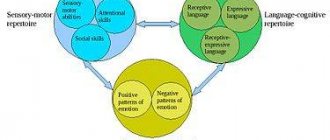Berne's transactional analysis helps people understand the causes of problems that manifest themselves during communication. The American psychologist identified three ego states that determine the psychology of behavior, human health and overall quality of life. Eric Berne analyzed communication and divided it into transactions, hence the name of the analysis. In psychotherapy, ego states are studied - systems of feelings and ideas that manifest themselves through different patterns of behavior. When communicating, a person takes a specific position, and it depends on this how he will react to what is happening, as well as how his interlocutors will perceive him.
Brief essence of the theory
In the theory of transactional analysis, the unit of communication is transactions (stimulus and response). The Parent-Parent line is needed for casual conversations and gossip. Adult-Adult – work, business relationships. Child-Child – for feelings and love. When transactions coincide, communication lasts a long time. Violation of transactions causes disagreements, conflicts and inadequate psychological interaction (guardianship, tyranny, manipulation, suppression, whims).
Functions
No person can remain in only one state all the time.
When exposed to certain stimuli, certain aspects of the personality are “turned on”
It matters which ego is dominant
All three states are important for interpersonal relationships and perform specific functions:
- The child’s task is creation, the creation of an emotional picture of desires, which will be a stimulus for further development. The child acts spontaneously, creates, gives birth to ideas.
- The task of a parent is care, training, guidance. Monitoring compliance with the rules, providing assistance, constructive criticism.
- The task of an adult is to adapt to the current situation, find a solution, and constructive dialogue. In other words, he must act in accordance with objective reality.
For example, a decision is made as follows:
- the child feels a desire to receive something, feels emotions;
- an adult is looking for ways to solve a problem;
- the parent monitors the correctness of execution, criticizes, guides, evaluates.
Child
Child – “I want”, “I like”. There is no need to describe anything here, just remember the classic behavioral characteristics of children: true emotions are never hidden, they dictate words and actions. What else do children do? They are capricious, hooligan, cry, laugh, get scared, get offended. Their vocabulary differs in the following expressions:
- I want, I don’t want;
- Amazing;
- tired;
- when will this all end;
- to hell with it all;
- I will never agree;
- I love you madly.
That is, the child is ruled by emotions and feelings, which is immediately reflected in behavior and communication. The child is responsible for spontaneity, ingenuity, charm (natural child), but at the same time he can be capricious, aggressive, rebellious, whiny, touchy (adaptive child).
How ego states work
All three positions are important, so don't try to stick to just one option. The main function of the “Child” ego state is to dream and wish, to enjoy life. This position helps you create and generate ideas.
The functions of the Parent are to take care of themselves and loved ones, teach, and also control the process of activity. The adult ego state is responsible for the ability to negotiate and adapt to the situation, look at things realistically, assess prospects sensibly and look for ways to implement plans.
It is worth paying attention to how a person usually achieves his goals. The child finds something he likes and gets excited about a new idea. The adult assesses the situation, begins to make plans and thinks about how to make the dream come true. The parent controls the process and monitors the results, reminding them what needs to be done. He can criticize or praise depending on the situation.
Parent
Parent – “should”, “shouldn’t”. When the parent awakens in us, we take a “hands on hips” pose, point a finger, express contempt or condescension with a smile. The gaze is heavy and directed downward. The sitting position is relaxed, the body is slightly tilted back. The parent always defends his position, teaches others, and considers only himself right. In the vocabulary of such a person there are expressions:
- I won't stand for this.
- You are completely wrong.
- Do as I say.
- You are required.
- It is forbidden.
- A fool understands.
- You can't really do anything.
The parent always strives to catch the opponent, identify contradictions in his judgments, and prove the speaker wrong. It relies on the information that was received in childhood from the family and social environment: norms, requirements, prohibitions. “Do as I do or do not as I do, but as I say,” is the position of the parent. He controls and cares. When a parent is completely blocked, the person becomes unprincipled and forgets about morality and rules of behavior.
Child
This state contains an echo of our childhood - it contains the feelings and needs that we experienced when we were children. This is a manifestation of our inner reality as it was before the age of 6-8.
The key word of this inner reality is “I want!”: I want to play, ride on a swing, eat ice cream... In its positive manifestation, this state gives a feeling of grown wings, encouragement, inspiration. When you want to rejoice in this world, scream with happiness, run happily somewhere.
Wanting only to have fun and play, the child is not interested in the consequences of his behavior. Moreover, he is not involved in any planning, formation, or distribution of resources.
There are no prohibitions or social norms for the child’s condition. More precisely, he does not understand and does not want to understand what it is. “Take it all out and put it in” for him. How exactly you “take it out” and how you “put it in” is not his business.
When a child is faced with a prohibition, with the impossibility of fulfilling his “I want”, protests, resentments, whims, crying begin - the negative aspect of this ego state manifests itself.
Adult
Adult – “expedient”, “useful”. Outwardly, a person with his entire appearance makes it clear that he is focused on the object and the topic of the conversation: he leans forward with interest, looks directly at the object, his eyes are slightly widened or narrowed. Attention and interest are written on the face. The following expressions predominate:
- I probably didn't express myself correctly, since you didn't understand me.
- Let's discuss this.
- Please repeat again.
- How do you like this proposal?
In general, he is an adult: he solves problem situations productively, and thinks sensibly. It’s a pleasure to deal with him, of course, as an adult.
An adult is the most objective position. It does not depend on the script laid down in childhood. This is something that a person has learned himself. An adult acts according to the “here and now” principle. Rationally solves the current problem. You can develop this role endlessly, throughout your life.
Complete blocking of an adult leads to the inability to respond to changes in the world. Human thinking is responsible for this role; it is a personal feature of collecting and analyzing information. A developed adult decides which stereotypes of the child and parent to turn off in the current situation and which to turn on.
Transactional analysis
The twentieth century gave the world many outstanding people. One of them is the American psychologist and psychiatrist Eric Berne (1910-1970), the creator of transactional analysis. His theory has become a separate popular trend in psychology, incorporating the ideas of psychoanalysis, behaviorism, and cognitive psychology.
E. Berne presented the theory of transactional analysis in a language accessible to readers in several works. Many of them have been translated into Russian and have remained bestsellers for more than half a century. His most famous books are: “Games People Play”, “People Who Play Games”, “Beyond Games and Scripts”.
And in the book “Transactional analysis in psychotherapy. Systemic Individual and Social Psychiatry” contains the entire coherent theory of E. Bern, and not only its main blocks, developed in subsequent publications - the analysis of games and scenarios - but also aspects that the author does not set out in his other books.
E. Bern
In a practical sense, transactional analysis is a system for correcting the behavior of individuals, couples and small groups. After familiarizing yourself with the works of E. Bern and adopting his concept, you can independently adjust your behavior so as to improve relationships with the people around you and yourself.
The central concept of the theory is transaction - the act of interaction between two individuals entering into communication, the basis of interpersonal relationships.
It is difficult to literally translate the word “transaction” from English, but in terms of meaning it is most often interpreted as “interaction,” although a transaction is not the entire interaction, but only its element, a unit of communication. Human interactions consist of many transactions.
A transaction includes a stimulus and a response. One person says something (stimulus), and the second person responds something (response).
A simple transaction example:
- Can I help you? (stimulus) - No, thank you, I’ll do it myself. (reaction)
If interaction were based only on the “stimulus-response” scheme, there would not be such a variety of human relationships. Why does a person behave differently with different people and reveal himself in a special way in his interactions?
The fact is that when communicating, one individual comes into contact with another person as a person with a person, or more precisely, some part of his personality with a part of the personality of another person.
Examples of role mismatch
In life, role discrepancies are not uncommon, which is why conflicts arise. Here's what it might look like in different areas.
Family
The husband, from the position of an adult, asks: “Darling, do you know where my tie is?” The wife, from the position of a parent, replies: “Where you left him. How small! "
In sales
The buyer, from the perspective of an adult, asks: “How much does this dress cost?” The seller answers irritably from the position of a parent: “You don’t have eyes, can’t you see it yourself?”
At work
A young specialist turns to a colleague or manager for help from the position of an adult: “Could you tell me which algorithm and program is best to use to solve this problem?” And in response he hears an irritated parent: “It’s high time to understand and know this yourself.”
In all three cases, an unprepared person who does not know role theory will also begin to play the role of a parent. As a result, endless reproaches and complaints will pour in from both sides. But if you learn to conduct transactional analysis and identify the positions of communication partners, then you can prevent conflicts in time.
Transactional Analysis
Transactional analysis is a psychological model that is used to analyze personal interaction in groups and individual behavior.
Transactional analysis is based on the principles of psychoanalysis, but unlike the latter, it describes human behavior and reactions in simple, accessible language.
A transaction, from the point of view of psychology, is a unit of interpersonal interaction, consisting of a message (stimulus) and a reaction to it.
That is, human communication is nothing more than an exchange of transactions. For example, greeting and response, question and response.
The following types of transactions are distinguished:
- Complementary. The outgoing stimulus from one person is complemented by the reaction of another. For example: “What time is it?” - Two hours. Both people communicate in the same state.
- Cross. The message intersects with the reaction. Most scandals are based on this. So the husband asks the question: “Where is my shirt?”, and in response he hears: “Why should I know this?” That is, the husband speaks from the position of an adult, and the wife answers from the position of a child.
- Hidden. This is the case when words do not match emotions. An individual says one thing, but his emotions and facial expressions say something else. Psychological games are based on this.
Transactional analysis is designed to answer the question of why the same person in different situations demonstrates different behavior and reacts differently to stimuli.
This is due to the use of one of the three ego states.
With the help of this analysis, you can learn to understand the behavior of other people, make decisions, demonstrate your emotions and feelings. Transaction principles are applied in the following areas:
- when interacting in teams;
- to build a family model;
- during friendly communication;
- in raising children.
In short, transaction techniques are used in all areas of interpersonal interaction.
How to use Berne's theory in communication
When we are exhausted and excited, then addressing us from the position of an adult can be regarded as an attack on our inner child. Who stands up for the children? Right. Parents, but they inadvertently (or deliberately) offend their children. So children and parents will fight until someone gets tired of it, or rather, until the body of one of the participants fails (hysteria, hypertension, fainting).
In general, the continuation of the story depends on the strength of expression of each of the roles in a person. If the parent is weak, then the person will face the reproach in silence, swallow and leave, complaining about his unfortunate fate. This does not change the essence: the problem will remain unresolved.
If you visually imagine a formed group of communication participants (two adults, two parents, two children), then this bazaar will start to give you a headache. But the problem is that only adults, who cannot be heard over the screams of parents and children, can solve problems productively. As a result, the problem either remains unresolved or is resolved after a scandal. But why then waste time on it? Isn’t it easier to immediately answer your opponent correctly?
Conflict, or rather resolving disagreements, can and should be done from the perspective of adults. This is called a productive conflict, the goal of which is to get to know each other better, understand and come to a common decision.
Psychological flexibility and the ability to outwardly obey will help with this. The point is that you agree with the claim presented to you, then compliment your opponent and repeat the request. In our example with a family, it may look like this: the husband will answer that he is really like a child, but his wife is smart, always knows where and what is, neat, and, of course, will help him find a tie and teach him how to maintain order.
This is not weakness, not a humiliation of personal dignity (probably now the child in you has spoken to you, who does not want to do this). This is a manifestation of the flexibility of the mind and psyche, the answer of an adult who is ready to quickly and constructively solve problematic issues. Flexibility implies the ability to easily and quickly adapt between the internal roles of an adult, a child and a parent. If this mobility is not present, then it is noted:
- the powerlessness of an adult under the dominance of a parent or child (I understood everything, but could not do anything);
- Indulgence of a parent to a child (for example, satisfying one’s “wants” against the backdrop of a weak financial situation or celebration, loans for a wedding).
A flexible person knows how to be different:
- At work, give priority to the adult, and place the child in last place.
- With friends in an informal setting or with a loved one alone, he will give free rein to his inner child.
- To fulfill traditions and norms, you will need a parent.
It is very good if your partner also has this psychological flexibility. Well, if it doesn’t, then you already know how to deal with it. How to develop a dominant adult role:
- Learn to respond promptly to the first calls from a child or parent, do not make automatic decisions, learn to calm down and wait. Self-regulation will help with this.
- Train yourself to ask in moments of doubt: “Is this true?”, “Where did this thought, desire come from?”, “Is this acceptable in this case?”
- When you are in a bad mood, ask yourself what or who the inner child is offended by.
- Learn to bring your partner into the role of an adult. To do this, it is enough to answer a couple of times according to the method described above, for example, to a boss who demands an impossible task and exclaims “Figure out how to do it yourself, after all, what are you here for!”: “If I knew how to do this and could think as good as you, then long ago I would have been a boss, not a subordinate. So how to do this? Yes, perhaps you will receive a few more reproaches, but if you remain as brave as you are, then all that remains for the boss is to descend from the position of a parent to the position of an adult. So, in order to bring your partner to the position of an adult, you need to agree with his reproach, and then ask a question.
- Never look down. It is ideal to look eye to eye. This is the position of an adult. The parent looks down from above, who in Bern's theory always attacks, makes claims (although sometimes takes care of him). It’s better to look a little from below (this is a child surrendering to the power of a partner), but behave like an adult.
Problem and signs of imbalance
A person can achieve success and prosperity if the three components of the ego interact harmoniously in him. Each state should account for approximately 30% of his time.
If you know the principles of transaction, then you can include a child, adult or parent in the right situation so that communication goes according to the desired scenario.
Unfortunately, not everyone has this balance. This leads to various communication problems. Most often, an individual is dominated by a parent or a child.
The child cannot make adult decisions, is late for work, blames others for failures, and gets offended.
The parent constantly teaches his other half, friends, partners.
These excesses negatively affect, first of all, the person himself. Imbalance problems are expressed as follows:
Child
If there is little child in a person, then she does not experience spontaneous desires, joy, or emotions. A child is a piece of childhood that remains with an individual for life.
Bern believes that this side is the most valuable. It allows you to remain spontaneous, delighted, and develop your creative potential.
The expressed side of the child, on the contrary, makes the individual irresponsible, undisciplined, and unable to achieve goals. He only wants to play, receive, but not give.
A depressed or rebellious child is very touchy and prone to depression. He needs parental care, depends on other people's opinions, and has low self-esteem.
If the ego-child is very dominant, then this becomes a serious problem. A person tends to blame other people for failures, does not draw conclusions from his mistakes, and accumulates grievances. These grievances and disappointments lead to depression, depression, and suicidal thoughts.
Hypertrophied parent
This is usually a boring, grumbling, lecturing person.
He does not recognize other people's opinions and criticizes. In relation to himself and others he expresses inflated demands, that is, he is a perfectionist.
The ego-parent tries to constantly control the situation and blames himself for failures. This side of personality that is too pronounced often becomes the cause of mental disorders. This can be avoided if you consciously change the script prescribed in childhood.
Adult problem
The problem for adults is that this side shows up too rarely. Not everyone is able to adequately assess reality, make the right decision, accept constructive criticism, or compromise.
True, the condition of an adult can and should be developed and increased. For example, a person experiences resentment as a result of a conflict. He should analyze the situation and understand whether the interlocutor really wanted to offend him or whether the ego-child was emotionally hurt.
Often, skilled manipulators try to evoke the child's emotions in order to achieve their goal.
The next time a conflict situation arises, you need to “turn on” the adult and “turn off” the child, that is, not fall for the manipulator’s hook.
Thus, a person can be considered mature if a balance has been achieved between the three sides of the ego. The immaturity of one side and the dominance of the other become a source of psychological problems.
Three ego states. Your first selves:
Our interesting VKontakte group:
Afterword
What is the difference between a constructive business conflict and a destructive one? In constructive, people discuss contradictions and try to understand the opposite side for the sake of a common solution and clarification of the truth. In a destructive argument, people try to defend their point of view and win. But is it possible to win? Are there any winners in a broken family, a layoff, or a fight? No. Each side will feel sorry for itself and consider itself betrayed.
The inability to psychologically competently resolve conflicts and be flexible in roles leads to relationships becoming chronically emotionally tense. As a result, they either fall apart, or the participants develop psychosomatic illnesses and neuroses. Berne's theory is a useful basis for studying the problem of conflicts (in the family, at work, in any interpersonal interaction) and their resolution.
The consequences of different parenting styles and how to mitigate them
The parent-child relationship is influenced by several factors:
Personal experience of raising parents themselves. In adulthood, people bring the disadvantages and advantages of the educational process that existed in childhood
For example, the appearance of younger family members was assessed as a negative phenomenon, because all the parents' attention was focused on the youngest. There is an idealization of childhood, excessive guardianship, and a desire to prolong the child’s childhood.
The result is a restriction of independence, the development of a consumer attitude and selfishness. Awareness of the mistake comes after a consultation, during which parents are advised to give more freedom to their children, understanding the difficulties encountered on the path of personal growth. Children make their own decisions, parents support them, regardless of the correctness of the choice made. Parents' aspirations that were not realized in childhood - lack of achievements. This internal attitude hinders the child’s social adaptation; he is forced to spend more time at home and pay attention to family members. The result is that the teenager becomes distant and spends a lot of time outside the home with strangers. The psychologist’s goal is to identify parents’ children’s problems, make them aware of their own unrealized plans, and perhaps confront them with the fact that it is never too late to engage in any type of activity. This approach shifts the parents' attention to themselves, freeing the child from constant control. Attachment. The fear of being alone forces the mother or father to demand the child's attention. Perhaps the parent spent his childhood in a single-parent family, and there was a shortage of male and female attention. The assessment of the pupil’s behavior is based on whether he creates the required emotional sensation for his parents or not. Parents need to work through this aspect, after which the relationship improves. Personal characteristics of adults surrounding the baby. Lack of understanding and flexibility leads to conflicts in adolescence. It's time for adults to stop seeing their son and daughter as small. A bad relationship or lack thereof with the child’s other parent can cause an internal struggle, a desire to change the person by influencing the offspring. The child does not understand what caused the behavior of, for example, the mother, he is forced to psychologically close himself off. Realizing and accepting the situation is the only way out so as not to destroy the relationship with your son or daughter.
The circumstances of the birth of a baby affect the relationship - unwanted pregnancy, difficult childbirth, long-term illness, gender discrepancy with the expected. These moments can cause alienation and rejection by the parent of the child.
Classification of parenting styles in psychology
The system of educational techniques is an unconscious set of methods. Awareness includes:
- understanding the goals of education;
- choice of techniques;
- setting goals;
- analysis of methods, taking into account experience.
There are 5 main types of educational influence:
- Guardianship. Parents provide all the baby’s needs, depriving him of initiative and the opportunity to take care of himself. The result of such upbringing is a person’s complete unadaptability to life. The child's independence is blocked.
- Dictatorship. Signs of dictatorship are coercion, ignoring the interests of the child, physical or mental abuse when trying to show resistance.
- Non-intervention or liberalism. One side of the issue is taking into account the interests of adults and children, on the other - coldness, inability of parents to learn to communicate, emotional distance.
- Cooperation is the most constructive community of close people, where everyone has the right to seek help.
- Parity is a group in which family members act according to a plan that ensures that all people get what they want.
In single-parent and two-parent families, mothers are involved in raising children. The father's role is to provide financial support for the cell's needs.









